Tomorrow, 9 February, is the 50th anniversary of the Boeing 747’s first flight. It’s a significant anniversary that sums up history and progress in aviation.
The original wide-body airliner is one of the two definitive commercial aircraft of the 20th century, the other being the Douglas DC-3. Both types revolutionised aviation by increasing the number of people travelling by air. The 747’s distinctive humped fuselage became the symbol of low-cost mass international air travel, which it largely pioneered. Supporting roles were played by the now forgotten McDonnell Douglas DC-10 and Lockheed L-1011 Tristar.
However, the 747 was intended to be no more than a stop-gap design. It was thought at the time that supersonic aircraft, such as Concorde, and Boeing’s SST design, would replace conventional intercontinental passenger aircraft and that the 747 would become primarily a freighter—hence the raised cockpit hump to allow loading through a lift-up nose. Boeing expected to sell about 400 of the 747.
Fifty years later, the fall-back position of its freight hauling ability is keeping the 747 in production. As Flight Safety Australia discussed in 2017, factors ranging from the age of the basic design to the changing nature of international air travel have resulted in passenger orders drying up for passenger versions of the 747. Existing users of the type are selling them off in favour of twin engine designs, such as Boeing’s own 777 and 787, that carry slightly fewer passengers but use significantly less fuel. Qantas will retire the last of its nine remaining 747s next year, replacing them with 787-9s.
Demand for the freight version remains viable, however, vindicating Boeing’s original business plan after more than 1500 sales. ‘The 747 is the highest-payload production freighter available, and the only Western-built production freighter with nose loading,’ George Dimitroff, head of valuations at Flight Ascend Consultancy told FlightGlobal.
As of January, FlightGlobal reports 169,747s are still serving as passenger aircraft, with the bulk of the in-service fleet—297 aircraft—flying as freighters. At least 20 of Boeing’s modest 24 outstanding orders for the 747 are for 747-8F versions (which as freight aircraft revert to the shorter hump of the first 747 models). The other four are for undisclosed customers.
The 50th anniversary of the original ‘Jumbo Jet’ is an opportunity to reflect on the continuous improvement in air transport safety since 1969. In 1970, there were 78 fatal airliner accidents, killing 1475 people. In 2017, the numbers were six accidents and 19 dead, (not a typo) despite passenger numbers having grown by more than a factor of 10, from 300 million to more than 4 billion.
It seems likely that Boeing 747s will keep flying for many years to come, although largely confined to nocturnal freight runs. But the type’s place in public consciousness is assured, with the next VC-25B US presidential aircraft to be adapted from the 747-8 model to replace the existing pair of 747-200s, designated VC-25A, that serve as Air Force One. There are two museum examples preserved in Australia (ex-Qantas aircraft at Longreach in Queensland and Albion Park, NSW). And repurposed 747s can be found serving as a youth hostel in Stockholm, Sweden, a restaurant in South Korea, and from later this year as an artificial diving reef in the sea near Bahrain.






I would add the B 737 as a definitive 20th century aircraft as well. it basically replaced the DC3.
Having served as a Captain of Boeing 747-400, 747-300, 747-200, 737-800, and 737-700 aircraft, I have developed a lot of respect for Boeing aircraft. They are a Pilot’s aircraft, very reliable, and comfortable to fly, both as a Pilot and as a passenger.
Seems a little biased toward American aircraft – dont forget the DH Comet, the first ever passenger jet. The VC 10 (probably the most beautiful commercial passenger jet ever) and its service to passengers of the former British Empire particularly Africa and lastly, a technical success, if not economic, the Concord – history will judge these aircraft as milestones in aviation at least the equal of the 707. 747 and the DC 3.
Just as the DC3 was preceded by the DC1 & 2, the Comet was the trail blazer for the B707. As beautiful as the Comet was, I still judge the original Dash-80 just as good looking.
There has been a lot of great A/C since the ‘Wright Bros’ started it all (from the Yanks POV) the B747 is just one of them. The Queen of the skies has become like a lot of A/C redundant!
Bit severe Walter, passenger travel patterns/demand has changed ,so for the foreseeable future small (two engine jobs) aircraft are the way to go but as “staff writer” said the big jets will still be around as freighters.